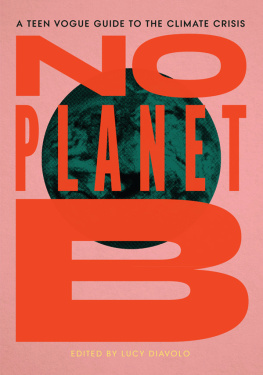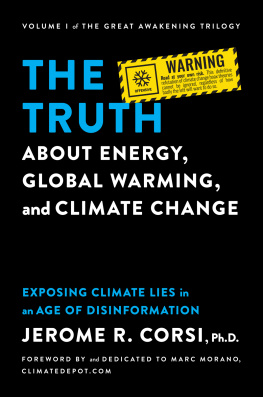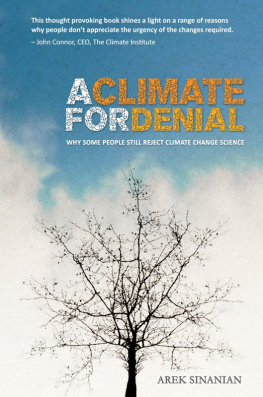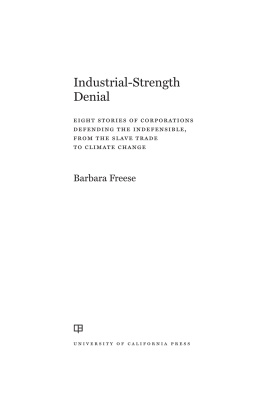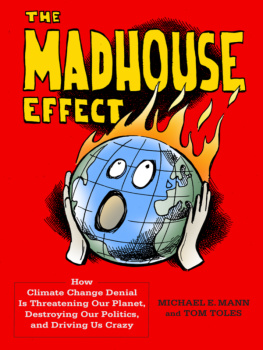Table of Contents
Guide
The views and conclusions are mine, but in researching and writing this book, Id like to express thanks to Jacob Arechiga, Stefan Bjrklund, John Constable, Chuck DeVore, Myron Ebell, Edgar Grtner, Steven Groves, Kathleen Hartnett-White, Chris Horner, Gordon Hughes, Hans Lundberg, Nick Loris, Mark Mills, Philipp Mller, Michael Nasi, Benny Peiser, Jeremy Rabkin, Birgit Reinhardt, Bo Theutenberg, Fritz Vahrenholt, and Alexander Wendt. Ian Tanner read and corrected the manuscript, which was subsequently edited by Barry Varela, designed by Chris Crochetire of BW&A Books, and overseen by Katherine Wong and Sam Schneider at Encounter Books. My agent, Keith Urbahn of Javelin, tirelessly and cheerfully championed the project throughout. A generous grant from the Searle Freedom Trust made this book possible. I am grateful to them all.
An author inflicts the greatest burden on his family. This one is no different and was repaid with tolerance and understanding by my wife. From the bottom of my heart, thank you.
The combination of intelligence and integrity is far rarer than it should be, especially in a field such as this. S. Fred Singer and David Henderson have both in abundance. As well as providing invaluable insights, Fred Singer features as a protagonist in two of the episodes recounted in the pages of this book, a role for which he has been traduced and attacked to this day. Long conversations with David Henderson inspired and shaped my first book and made this one much better. We are now collaborating on a third, which is on a different subject. Both men are models of what an intellectual warrior dedicated to truth seeking should be.
This book is dedicated to them.
I attempted to rise, but was not able to stir:
for, as I happened to lie on my back, I found my
arms and legs were strongly fastened on each
side to the ground; and my hair, which was long
and thick, tied down in the same manner.
Jonathan Swift, Gullivers Travels
If only everyone could be like the Scandinavians,
this would all be easy.
Barack Obama
This book is about freedom. It is about its loss as a result of policies designed to slow down what is presumed to be man-made global warming. Avoiding planetary catastrophe gives a president and the executive branch a higher dispensation than that granted by the Constitution. Obamacare was implemented under the Affordable Care Act. Implementation of the Clean Power Plan was by administrative fiat and the Senate bypassed when the United States ratified the 2015 Paris Agreement: Americas eighteenth-century Constitution is not going to be allowed to impede a project in which society is to be radically transformed through the agency of the state. As the embodiment of an ideal of freedom, the Constitution is incompatible with a project that is alien to the tradition of liberty flowing from Americas founding, though not to the ideologies, originating in Europe, from which the project first sprang. The two cannot coexist. One or other will prevail and define America for decades to come.
The vast gap between American hard power and that of the rest of the world sometimes blinds Americansespecially American conservativesto Americas vulnerability to other countries soft power. America invented Earth Day in 1970 and gave birth to postwar environmentalism with Rachel Carsons Silent Spring (1962). Yet even these seemingly all-American products drew on ideas from across the Atlantic and from across the chasm of the Second World War; the cancer chapter in Rachel Carsons Silent Spring, for instance, incorporated the Nazi belief that industrialization was causing a cancer epidemic.
If there was a purely American strand of environmentalism, the demands it made on America were fairly limited. The costs of banning DDTthe principal policy consequence of Silent Springwere mainly inflicted on Africans exposed to the risk of malaria. Thanks to the availability of cheap substitutes, phasing out CFCs a decade and a half later to preserve the ozone layer hardly required Americans to change their lifestyles. Preserving habitats and wildernesses did not necessitate transforming American society and culture.
There is a strand of American apocalyptic thinking that was first initiated by scientists after 1945 in reaction to the atomic bomb. But this scarcely amounted to an ideological challenge to the basis of American capitalism. That came when it was mixed with the post-Marxist environmentalism developed by German exiles and subsequently weaponized by the progressive left in America. They were the prophets who prepared the way. Their student followers in Germany would come to form the leadership of the Greens in the early 1980s. Nazi ecological politics were rehabilitated by the Greens and would come to form part of mainstream German and then European politics. What united them was a deep hostility to capitalism and the free market. Against them stands the Jeremiah of capitalism. Far from wishing to see capitalism fail, Joseph Schumpeter foresaw its death coming from its own hand; although writing in the 1940s, he could not have foreseen that the instrument of its self-destruction would be environmentalism.
This, then, is the ideological landscape across which the action unfolds. At the end of the 1960s, while American environmentalists were focusing their efforts on banning DDT, Sweden was putting coalthe most ubiquitous source of electrical energyin the crosshairs when it made acid rain the worlds top environmental problem. By making energy the focus of international action, it gave environmentalism control of the dial to transform the basis of industrial civilization.
In the past, waves of spontaneous innovation transformed the fabric of American society, vastly improving Americans quality of life. None was as transformational as cheap, ubiquitous electrical power. It bade farewell to the age of steam, gaslight, and paraffin. Grid-supplied electricity separated the twentieth century from the nineteenth and triggered a social revolution. Electrical appliances replaced domestic servants, and the liberation of women from household drudgery began.
This one is differenta planned societal and cultural transformation directed by the administrative state. Within a year of Barack Obamas election to the White House, such a transformation was being discussed by European climate change radicals and senior Democrats at a conference in Germany. Where Europe led, America would follow.
This book tells the story of two countries and three environmental scares. Two originated in Sweden (acid rain and global warming) and one (the nuclear winter) was transmitted from Moscow via Stockholm.
Sweden
Sweden was to have an influence on world affairs and the environmental politics of the United States out of all proportion to its eight million people. From the late 1960s through to the late 1980s and the establishment of the Intergovernmental Panel on Climate Change (IPCC), which, far more than any other nation, has the rightful claim to paternity (Chapter 11), Sweden was extraordinarily successful at projecting environmental diplomacy on the world stage. Its Social Democratic rulers, in particular its prime minister, Olof Palme, had compelling reasons to mobilize environmentalism for political ends. A widely unpopular civil nuclear power program would, in 1976, help bring to an end 48 years of unbroken Social Democratic rule.
Acid rain (Scare #1) was the dress rehearsal for global warming. The politicized science of acid rain swept all before it, the bar set low in the first government report on acid rain, which happened to be written by Bert Bolin, a friend of Palme and future first chair of the IPCC (Chapter 6). It spread to Germany, where hysteria about forest death destroyed any hope of rationality and objectivity. It was taken up by Canada, which waged a relentless campaign to get the United States to cut its power station emissions. The Reagan Administration held firm against virtually unanimous scientific opinion. Elected as the environmental president, George H. W. Bush gave the Canadians what they wanted. However, the science was not as solid as the consensus asserted, and a ten-year federal study revealed it for what it was. Scandalously, the Environmental Protection Agency (EPA) suppressed its findings until the main provisions of the acid rain legislation had been agreed in Congress (Chapter 7). Despite its falsification, as of this writing, the EPA still maintains that sulfur dioxide from power station emissions makes lakes acidic and damages forests and woodlands.
Next page

